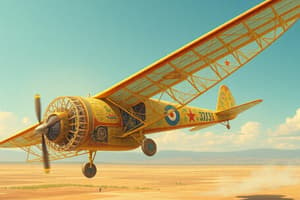Podcast
Questions and Answers
Which of the following best describes the relationship between flights and passengers?
Which of the following best describes the relationship between flights and passengers?
- Passengers are linked to an airport rather than a flight.
- A flight can have multiple passengers, each needing a separate ticket. (correct)
- Each flight can only accommodate a single passenger.
- Each passenger can operate multiple flights simultaneously.
What entity is responsible for the operation of a flight?
What entity is responsible for the operation of a flight?
- The airport authorities
- The airline owning the plane (correct)
- The flight itself
- The passengers of the flight
What role do the pilot and co-pilot fulfill in the flight model?
What role do the pilot and co-pilot fulfill in the flight model?
- They operate the flight. (correct)
- They are responsible for planning the flight route.
- They are responsible for the maintenance of the aircraft.
- They manage the passenger boarding process.
In a flight model, how is the relationship between cities and airports best described?
In a flight model, how is the relationship between cities and airports best described?
What is a characteristic of a flight in the modeled system?
What is a characteristic of a flight in the modeled system?
What does encapsulation achieve in object-oriented programming?
What does encapsulation achieve in object-oriented programming?
In the UML class diagram provided, which of the following attributes is correctly defined for the Car class?
In the UML class diagram provided, which of the following attributes is correctly defined for the Car class?
Which statement about data hiding in encapsulation is true?
Which statement about data hiding in encapsulation is true?
What is a consequence of encapsulation in software design?
What is a consequence of encapsulation in software design?
Which of the following methods is not likely part of the Car class based on the information given?
Which of the following methods is not likely part of the Car class based on the information given?
Which of the following best describes the benefit of implementation hiding?
Which of the following best describes the benefit of implementation hiding?
In the provided UML diagram, which data type is incorrectly assigned in any of the class attributes?
In the provided UML diagram, which data type is incorrectly assigned in any of the class attributes?
Which of the following methods is used for sorting in the example given?
Which of the following methods is used for sorting in the example given?
What does inheritance enable in object-oriented programming?
What does inheritance enable in object-oriented programming?
Which of the following best describes a superclass?
Which of the following best describes a superclass?
In UML notation, how is inheritance represented?
In UML notation, how is inheritance represented?
What is the purpose of building a general base class in inheritance?
What is the purpose of building a general base class in inheritance?
Which aspect of polymorphism describes how the same operation can behave differently?
Which aspect of polymorphism describes how the same operation can behave differently?
What defines a method in the context of polymorphism?
What defines a method in the context of polymorphism?
What is a primary advantage of using inheritance to build software incrementally?
What is a primary advantage of using inheritance to build software incrementally?
Which of the following is NOT a characteristic of the subclass?
Which of the following is NOT a characteristic of the subclass?
What is the unique identity of an object referred to?
What is the unique identity of an object referred to?
Which of the following statements about objects and classes is true?
Which of the following statements about objects and classes is true?
What does classification of objects refer to in the context of object-oriented programming?
What does classification of objects refer to in the context of object-oriented programming?
Why might cows and cars be modeled as separate classes despite having common attributes like price and age?
Why might cows and cars be modeled as separate classes despite having common attributes like price and age?
What is the main purpose of abstraction in programming?
What is the main purpose of abstraction in programming?
Which statement best describes the relationship between an object and its class?
Which statement best describes the relationship between an object and its class?
In object-oriented programming, what does the term 'object handle' refer to?
In object-oriented programming, what does the term 'object handle' refer to?
Which of the following is an example of abstraction in programming?
Which of the following is an example of abstraction in programming?
What is a primary function of a class in object-oriented modeling?
What is a primary function of a class in object-oriented modeling?
What does it mean for an operation to be polymorphic in the context of classes?
What does it mean for an operation to be polymorphic in the context of classes?
How is an attribute typically characterized in an object-oriented class?
How is an attribute typically characterized in an object-oriented class?
In a class diagram, which compartment is optional when modeling classes?
In a class diagram, which compartment is optional when modeling classes?
What is true about objects of the same class in relation to operations?
What is true about objects of the same class in relation to operations?
What is a class model primarily used for?
What is a class model primarily used for?
Which of the following statements about attributes in a class is false?
Which of the following statements about attributes in a class is false?
Which characteristic differentiates an operation from a method in classes?
Which characteristic differentiates an operation from a method in classes?
Which method in the Shape class is used to retrieve the color of the shape?
Which method in the Shape class is used to retrieve the color of the shape?
What is the primary purpose of a class model in object-oriented systems?
What is the primary purpose of a class model in object-oriented systems?
In which scenario are generics used in a class?
In which scenario are generics used in a class?
What does polymorphism allow in object-oriented programming?
What does polymorphism allow in object-oriented programming?
What do the methods setSide() and getSide() in the Square class represent?
What do the methods setSide() and getSide() in the Square class represent?
Which of the following statements accurately describes objects in OO modeling?
Which of the following statements accurately describes objects in OO modeling?
What does the method getArea() in the Rectangle class calculate?
What does the method getArea() in the Rectangle class calculate?
Which relationship is commonly characterized in a class model?
Which relationship is commonly characterized in a class model?
Flashcards
Object Identity
Object Identity
A unique identifier that distinguishes an object from all other objects in a system. It's essentially the object's memory address or handle.
Object Identifier
Object Identifier
A variable that references an object's identity (memory address). It's like a name tag that points to a specific object.
Class
Class
A blueprint or template that defines the common characteristics and behavior of a set of objects. It's like a recipe for creating instances.
Object
Object
Signup and view all the flashcards
Classification
Classification
Signup and view all the flashcards
Abstraction
Abstraction
Signup and view all the flashcards
Semantic Purpose
Semantic Purpose
Signup and view all the flashcards
Class Diagram
Class Diagram
Signup and view all the flashcards
Polymorphism
Polymorphism
Signup and view all the flashcards
Generic Class
Generic Class
Signup and view all the flashcards
Class Model
Class Model
Signup and view all the flashcards
Objects in Problem Description
Objects in Problem Description
Signup and view all the flashcards
Encapsulation
Encapsulation
Signup and view all the flashcards
Data Hiding
Data Hiding
Signup and view all the flashcards
Implementation Hiding
Implementation Hiding
Signup and view all the flashcards
Inheritance
Inheritance
Signup and view all the flashcards
Superclass
Superclass
Signup and view all the flashcards
Subclass
Subclass
Signup and view all the flashcards
Inheritance (from a different perspective)
Inheritance (from a different perspective)
Signup and view all the flashcards
Method
Method
Signup and view all the flashcards
Operation
Operation
Signup and view all the flashcards
Polymorphism (explained further)
Polymorphism (explained further)
Signup and view all the flashcards
Attribute
Attribute
Signup and view all the flashcards
Value
Value
Signup and view all the flashcards
Study Notes
Lecture 4: Introduction to UML, OO Modelling, & Class Diagrams
- This lecture introduces the Unified Modeling Language (UML) in object-oriented (OO) software modeling.
- OO software organizes as a collection of discrete objects that incorporate data structure and behavior.
- The basic unit is the Object, which has state (data) and behavior (operations).
Topics Covered
-
Modeling
-
UML Diagrams
-
UML Tools
-
Static Diagrams
-
Class Model
-
What is OO Software?
-
Object-Oriented (“OO”) Characteristics
-
Identity
-
Classes and objects
-
Classification
-
Abstraction
-
Encapsulation
-
Inheritance
-
Using Inheritance
-
Polymorphism
-
Generics
-
Class Model
-
Objects
-
Values and attributes
-
Operations and Methods
-
Summary of Basic Class Notation
-
Sample Class Model
The Software Process
- A structured set of activities to develop a software system.
- Many processes exist, but they all involve Specification, Design/Implementation, Validation, and Maintenance/Evolution.
Modeling
- A model is an abstraction.
- Abstraction is used to simplify design by ignoring unnecessary details.
- Modeling tools reduce complexity, allow testing before implementation, facilitate communication, and document/visualize ideas.
Some UML Diagrams
- Functional diagrams: describe system functionality from user perspective, including use case diagrams.
- Static diagrams: describe the static structure of a system, including classes, objects, attributes, and associations
- Dynamic diagrams: describe dynamic behavior, including interaction diagrams (interactions between system objects), state diagrams (behavior of an individual object), and activity diagrams (system workflow).
UML Tools
- Some tools can generate code from UML diagrams.
- Other tools are for sketching.
- Rational Rose is a popular commercial UML tool.
- Bouml is an open-source UML tool.
- Visio is a sketching tool.
Static Diagrams
- Class diagrams: show classes and their relationships
- Object diagrams: show objects and their relationships
- Package diagrams: show how classes are grouped into packages.
Class Model
- A class model describes the static structure of a system by defining classes, objects, relationships, and details of each class of objects' attributes/operations.
- In OO systems, building around objects is more important than focusing solely on functionality.
What is OO Software?
- OO software organizes as a collection of discrete objects that have both data structure and behavior.
- Objects have state and behavior.
Object-Oriented (“OO”) Characteristics
- Identity
- Classification
- Encapsulation
- Abstraction
- Inheritance
- Polymorphism
- Generics
- Cohesion
- Coupling
Identity
- Each object has its own unique identity, even if objects have the same state/data.
Classification
- Objects with the same data structure (attributes) and behavior (operations) belong to the same class.
- Classes function as abstractions defining crucial application properties.
Abstraction
- Abstraction is selective study of problem parts.
- Developers isolate essential problem aspects and disregard less significant ones.
Encapsulation
- Encapsulation separates external and internal object details, improving program parts' interdependency.
- Changing a class's internal aspects doesn't affect programs using its objects.
Inheritance
- Inheritance is the feature that allows classes to share attributes and operations based on a hierarchical relationship.
- A superclass (parent) possesses general features and sublcasses (children) inherit those features, refining some
How to Use Inheritance
- Build fundamental classes to address basic cases.
- Build special cases (subclasses) that inherit from general classes, adding unique functions.
Polymorphism
- Polymorphism allows the same operation to have different behaviors in various classes.
- An operation is a procedure; a method is its specific class implementation.
- Polymorphic operations can have multiple implementations (methods) in different classes.
Generics
- Generic classes allow object attribute data types to be specified at run-time instead of compile time.
- Generic classes are parameterized, using a parameter that describes the attribute type.
Objects
- Objects often correspond to real-world entities or conceptual descriptions.
- Objects are identified by names, like variables in a program, which are often proper nouns.
Class
- A class is a blueprint defining a group of objects with shared properties (attributes) and behaviors (operations).
Class Model
- Class modeling involves a graphical notation to define classes and their relationships, depicting instances.
- Class diagrams are valuable in program/software design and implementation.
Values and Attributes
- Attributes represent properties of a class.
- Every class is defined by unique attributes.
- Values are data assigned to attributes
Operations and Methods
- Operations are procedures or functions applied to class objects.
- Methods are specific operation implementations within a class.
- Operations/Methods can vary or change across classes.
Summary of Class Notation
- Attribute and operation compartments are optional.
- Designers/developers can display or exclude attributes and operations as desired.
- Empty attributes indicate they have been specified but are nonexistent.
Summary of Basic Class Notation
- Basic class notation shows attribute name, type and default value.
- A class may have multiple compartments.
A Sample Class Model
- This model describes flight classes representing flights, airports, airlines, planes, passengers, pilots, and co-pilots.
- Each class has specific attributes and behaviors related to flights.
Studying That Suits You
Use AI to generate personalized quizzes and flashcards to suit your learning preferences.




